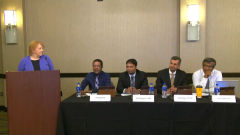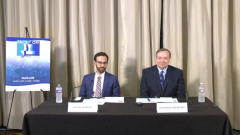
Relapsed/Refractory Multiple Myeloma: The CARTITUDE-4 Study
Key opinion leader Prashant Kapoor, MD, FACP, shares data from the CARTITUDE-4 study of ciltacabtagene autoleucel in patients with relapsed/refractory multiple myeloma.
Episodes in this series

Transcript:
Judy Schreiber, PhD, RN: We’ll move on to CARTITUDE-4 [NCT04181827] with Dr Kapoor.
Prashant Kapoor, MD, FACP: I am presenting the data from CARTITUDE-4 that were recently presented at the [2023] American Society of Clinical Oncology [ASCO] [Annual] Meeting [in Chicago, Illinois] as well as [the] European Hematology Association [2023 Congress in Frankfurt, Germany] in early June. This was a late-breaking abstract at the ASCO 2023 meeting. It is comparing cilta-cel, or ciltacabtagene autoleucel, which is a CAR T-cell therapy against BCMA, with standard-of-care regimens of daratumumab in combination with pomalidomide and dexamethasone or pomalidomide in combination with bortezomib and dexamethasone. As you can see in this figure, there are 2 binding domains in the cilta-cel structure, and recently there were updated data of CARTITUDE-1 [NCT03548207], which is a single-arm study, the first study to show [data] that cilta-cel was very effective in a heavily pretreated population, and these data were updated at ASCO 2023 as well, with a median PFS [progression-free survival] close to 3 years in this heavily pretreated population. As far as the study schema [for] CARTITUDE-4 goes, as opposed to CARTITUDE-1, [it] was being examined in [a] less heavily pretreated patient population with 1 to 3 prior lines of therapy, including a proteasome inhibitor and an immunomodulatory agent.
Importantly, all patients were lenalidomide refractory. Some of the key exclusion criteria included prior CAR T-cell or BCMA-targeting therapy, and the patients were [randomly assigned] in 1:1 fashion and stratified by the choice of therapy, PVD [pomalidomide, bortezomib, and dexamethasone] vs DPD [daratumumab-pomalidomide-dexamethasone], ISS [International Staging System] stage, as well as number of prior lines of therapy. Altogether, 516 patients were screened, of which 419 were [randomly assigned]: 208 to the cilta-cel arm and 211 to the standard-of-care arm. Ultimately, 176 patients went on to receive cilta-cel, with 32 patients not receiving it as part of the study, with 2 deaths and 30 progressions at the time of bridging. Ultimately, 143 patients had ongoing posttreatment at the time of this analysis risk [who] continued to follow up. In the standard-of-care arm, there were 211 patients, of which 208 went on to receive standard-of-care therapy.
The median follow-up was close to 16 months and the median time from first apheresis to cilta-cel infusion was [more than] 11 weeks. Here you can see the baseline characteristics, and they were quite comparable between the 2 arms. The median age was about 61 years in both arms. About 65% of patients were [at] ISS stage I, and 21% of patients had extramedullary disease. The median prior lines of therapy was 2, ranging from 1 to 3 per the eligibility criteria. Sixty percent of patients [had] cytogenetically high-risk [disease], and this was about 35% when we eliminated patients who had gain or amplification of [the] long arm of chromosome 1. As indicated before, all patients were lenalidomide refractory, but about 14% [had] triple-class refractory [disease] and 23% in the cilta-cel arm were daratumumab refractory vs 21% in the standard-of-care arm. Here you can see the PFS curves, and the PFS was the primary study end point, with median PFS not being reached at median follow-up of about 16 months in the cilta-cel arm vs a median PFS of roughly a year, or 11.8 months to be precise, in the standard-of-care arm, with 12-month PFS rates of 76% vs 49%. And lower down you can see the overall response rates, which were again superior in the cilta-cel arm, with [approximately] 85% of patients responding vs only two-thirds of patients responding in the standard-of-care arm. Importantly, the odds ratio for achieving CR [complete response] or better was [more than] 10, with 73% of patients achieving at least a CR in the cilta-cel arm vs only 21% in the standard-of-care arm, with 12-month duration of response of nearly 85% vs 63% in the standard-of-care arm.
If we specifically look at deeper remission rates, 60% of patients [showed] negative [results for] MRD [minimal residual disease] at some point during the follow-up in the cilta-cel arm vs [approximately] 16% in the standard-of-care arm. Again, cilta-cel PFS rates have been shown here regarding the prior line of therapy, which as you may recall, was one of the stratification factors, and the patients who had received only 1 prior line of therapy and had been assigned to [the] cilta-cel arm did the best. In the subgroup analysis, which is preplanned, the cilta-cel arm was superior in all the groups or subgroups, including patients who had previously been exposed to daratumumab, patients [with] standard-risk or high-risk [disease], and patients who had triple-class refractory [disease] vs the standard of care. If we specifically look at the per protocol analysis and look at 176 patients who had received cilta-cel, almost all patients responded. And as you can see, this is spectacular at 99.4%, with 86% of patients achieving at least a complete remission.
To your right you can see the PFS curve of patients who had received cilta-cel, with a PFS rate of 90% at 1 year in this study. In terms of the safety of this therapy, there were no new signals noted. Most toxicities were essentially hematologic toxicities—importantly, there were some second primary [malignant tumors] noted in both groups—[and] the vast majority were cutaneous or noninvasive [malignant tumors]. But there were 3 hematologic [malignant tumors], including 1 case of AML [acute myeloid leukemia], 1 case of MDS [myelodysplastic syndrome], and 1 case of peripheral T-cell lymphoma in patients in the cilta-cel arm. In terms of the neurotoxicities, there [was a] 4.5% rate of ICANS [immune effector cell-associated neurotoxicity syndrome] in the cilta-cel arm and 76% [rate] of any-grade CRS [cytokine release syndrome], but the grade 3 or 4 CRS rates were low as well as grade 3 or 4 neurotoxicity rates. There were some cases of cranial nerve palsy, [with] 9.1% in the cilta-cel arm.
All patients had cranial nerve 7 palsy, and 2 patients also had either cranial nerve 3 or cranial nerve 5 palsy. In most patients, these cranial nerve palsies had recovered at the time of last follow-up and there was 1 movement in neurocognitive treatment-emergent adverse effect also noted. In conclusion, there was a significantly prolonged PFS in the cilta-cel arm compared with the standard-of-care arm, with a hazard ratio of 0.26 in a modified log-rank analysis, where there was more weight given following infusion of cilta-cel as opposed to during bridging therapy. But in the sensitivity analysis, the hazard ratio was 0.40 if we were to look with the regular log-rank comparison. The PFS benefit was seen across all groups, and there were no new safety signals noted in this patient cohort that was less heavily pretreated. Importantly, compared with CARTITUDE-1 [findings], the rates of CRS, ICANS, MNT [movement and neurocognitive treatment-emergent adverse events], and some cytopenias were lower, suggesting possibility of improved tolerability of this approach if used early in the treatment paradigm.
Transcript edited for clarity.
Newsletter
Stay up to date on recent advances in the multidisciplinary approach to cancer.



















































































